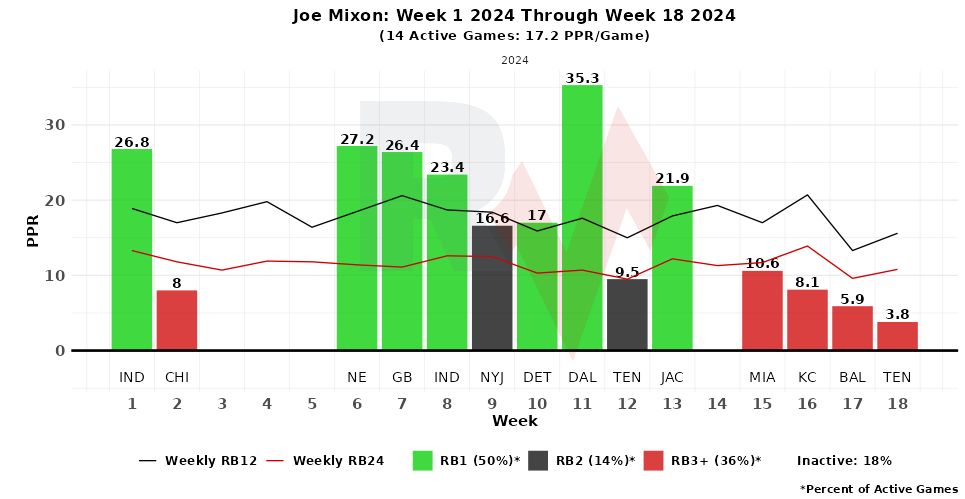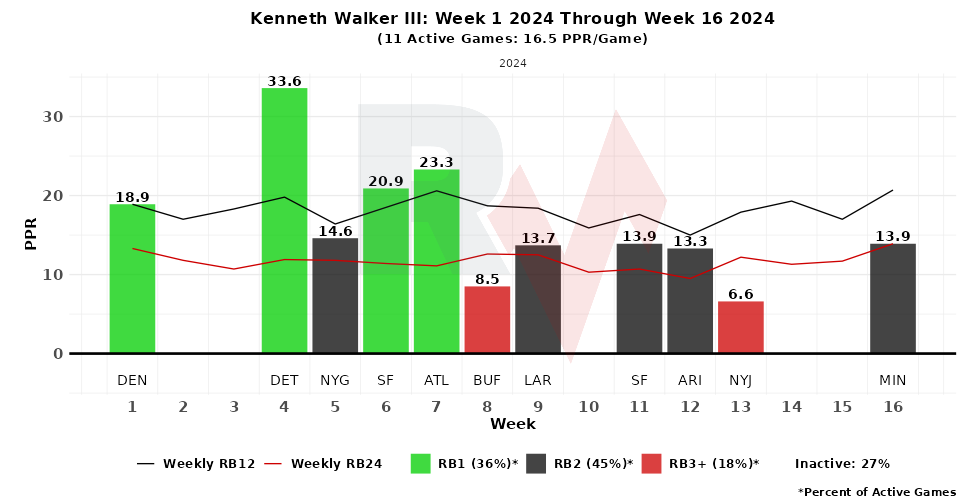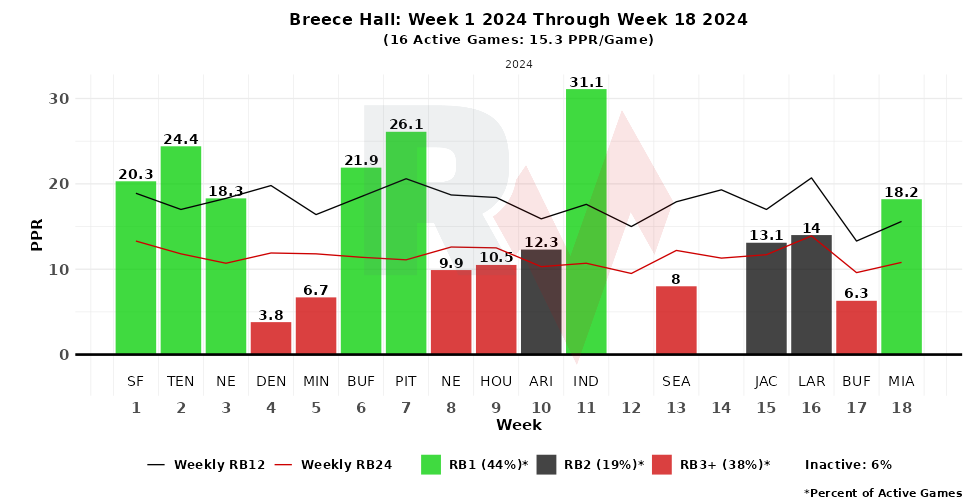Brandon Murchison's fantasy football analysis for offensive line busts and potential running back fallers. His OL breakdown for the Texans, Seahawks, Giants, and Jets in 2025.
In fantasy football, the success of running backs often hinges on factors beyond their individual talent, with offensive line play standing as a critical determinant of their production. A strong offensive line creates running lanes, protects against negative plays, and sustains drives, directly impacting a running back’s ability to accumulate yards and score touchdowns. Among the metrics used to evaluate offensive line effectiveness, stuff percentage—the rate at which a running back is tackled at or behind the line of scrimmage—offers a revealing glimpse into how well a line supports its backfield. A lower stuff percentage typically correlates with a running back’s efficiency and fantasy output, as it indicates fewer wasted plays and more opportunities for positive yardage, making it a key statistic for fantasy managers to consider when drafting or starting players.
The correlation between stuff percentage and running back success is evident in recent NFL trends. For example, in 2024, the Philadelphia Eagles' offensive line, widely regarded as one of the league’s best, posted a stuff percentage of just 14.2%, allowing Saquon Barkley to average 5.2 yards per carry and rack up 1,392 rushing yards, finishing as a top-five fantasy running back. Conversely, running backs behind porous lines, such as the Washington Commanders’ unit with a 22.7% stuff percentage, saw players like Brian Robinson Jr. struggle, averaging only 4.0 yards per carry with frequent negative runs, which capped his fantasy ceiling. These disparities highlight how offensive line performance, as measured by stuff percentage, can make or break a running back’s fantasy value, often overshadowing raw athletic ability or volume-based projections.
For fantasy managers, prioritizing running backs tied to strong offensive lines with low stuff percentages can provide a competitive edge in 2025 drafts and weekly lineup decisions. Teams like the Detroit Lions and Kansas City Chiefs, which consistently rank among the league leaders in run-blocking grades and boast stuff percentages below 16%, offer fertile ground for running backs like Jahmyr Gibbs and Isiah Pacheco to thrive. By contrast, backs playing behind lines with high stuff percentages, such as those of the New York Giants or Los Angeles Chargers, face uphill battles that can suppress their fantasy output. As the 2025 season approaches, savvy managers should lean on metrics like stuff percentage to identify running backs poised for success and avoid those likely to be stifled by subpar blocking, ensuring more reliable and explosive fantasy rosters. In this article, I look at some players who could potentially disappoint fantasy managers in 2025 as they face trying circumstances behind poor offensive lines.
Be sure to check all of our fantasy football rankings for 2025:- 2025 fantasy football rankings
- Running back (RB) rankings
- Wide receiver (WR) rankings
- Quarterback (QB) rankings
- Tight end (TE) rankings
- Defense (D/ST) rankings
- Kicker (K) rankings
- FLEX rankings
- Dynasty rankings
Joe Mixon - RB, Houston Texans
Joe Mixon could be a potential 2025 fantasy football bust due to his vulnerability to a high stuff percentage, exacerbated by the team’s deteriorating offensive line play. In 2024, Mixon posted a respectable 1,016 rushing yards and 11 touchdowns on 245 carries. Still, his efficiency metrics raise concerns, with a 4.1 yards per carry (YPC) average and a 20.4% stuff percentage, ranking 27th among 40 qualifying running backs (according to Fantasy Points Data).
The stuff percentage—indicating runs stopped at or behind the line of scrimmage—reflects the Texans’ offensive line struggles, which ranked 31st in ESPN’s run block win rate (51.2%) and allowed 43 tackles for loss on running plays.
The departure of left tackle Laremy Tunsil, replaced by Cam Robinson (who graded 60.0 or worse in run blocking for six straight seasons), alongside the retention of three other starters who graded below 64.0 in run blocking, signals persistent issues.
Mixon’s late-season fade, averaging 35.3 rushing yards per game over his final six games, including a dismal 26 yards on nine carries against Baltimore, underscores how a poor line can stifle his production, especially against stout defenses.
With new offensive coordinator Nick Caley potentially maintaining a run-heavy scheme but lacking proven play-calling experience, Mixon’s high-volume role (14th in snap share, fifth in opportunity share in 2024) may not translate to efficiency, capping his fantasy upside as an RB2 with bust potential.
Further compounding Mixon’s bust risk is the Texans’ evolving backfield competition and offensive uncertainties. The team signed Nick Chubb and drafted Woody Marks in the fourth round, signaling a possible shift toward a committee approach to preserve Mixon, who turns 29 in July 2025 and has 1,881 career touches, raising durability concerns.
Marks, projected to handle passing-down duties, could erode Mixon’s receiving work, which dropped to 36 catches for 309 yards in 2024 from 52 for 376 in 2023, diminishing his PPR value.
The Texans’ offense, which ranked 22nd in total yards and 19th in points in 2024, faces additional challenges with quarterback C.J. Stroud coming off a down season (3,927 passing yards, 22 touchdowns, 12 interceptions) and looking to rebound as the team added two rookies (Jayden Higgins and Jaylin Noel) to replace the departed Stefon Diggs and Tank Dell, who is likely to miss most or all of 2025.
A weaker passing game could lead to stacked boxes, increasing Mixon’s stuff percentage, as seen in games like his 2.9 YPC performance against Kansas City’s top-5 run defense.
With Houston’s offensive line unlikely to improve significantly despite offseason competition for starting spots, Mixon’s reliance on volume over efficiency, combined with tougher defensive game scripts, makes him a risky pick likely to underperform his RB17 ADP in 2025 drafts and a player that it may pay off for you to let other fantasy managers deal with.
Kenneth Walker III - RB, Seattle Seahawks
First and foremost, I'd like to point out that I am a big fan of Kenneth Walker III and the big-play potential that he provides with his running style. However, there is a slight risk of bust potential once you delve further into the challenges of the Seattle Seahawks' offensive line and potential obstacles in implementing new OC Klint Kubiak's scheme.
In 2024, Walker averaged a career-low 3.7 yards per carry (YPC) on 153 attempts for 573 yards, with a 22.1% stuff percentage—ranking 33rd among 40 qualifying running backs (per Fantasy Points Data)—indicating he was stopped at or behind the line of scrimmage on over one-fifth of his carries.
The Seahawks’ offensive line, which ranked 29th in PFF’s run-blocking grade (54.8) and 28th in ESPN’s run-block win rate (52.3%), lost key contributors like run-blocking tight end Will Dissly and tackle Jake Curhan to free agency.
Despite additions like first-round guard Grey Zabel (86.4 college run-blocking grade) and returning Charles Cross (77.9 run-blocking grade), the line’s other three spots are held by mid-round picks with PFF run-blocking grades below 62.0, suggesting limited improvement.
Walker’s efficiency, already hampered by a bottom-10 line, could worsen if Kubiak’s zone-heavy scheme (top-7 in zone frequency in prior stops) doesn’t gel with a line better suited to gap concepts, where Walker averaged 4.0 YPC versus 4.4 on zone runs.
His early-season success (22.3 PPR points per game over five games) faded as injuries and line issues mounted, with only one 100-yard game post-Week 5, signaling bust potential if drafted as a high-end RB2.
Walker’s bust risk is further amplified by backfield competition and injury concerns that exacerbate the impact of poor line play. Zach Charbonnet, a 2023 second-round pick, capitalized on Walker’s 2024 injuries (ankle, calf, shoulder; six games missed), averaging 25.9 PPR points per game in Weeks 14-15 with 188 rushing yards and three touchdowns on 30 carries.
Charbonnet’s 135 carries and eight touchdowns in 2024, often in passing situations or when Walker was sidelined, suggest a growing role, especially in Kubiak’s offense, which historically features running backs in the passing game (top-12 fantasy RBs in three of four prior stops).
Walker’s career-high 46 receptions for 299 yards (6.5 YPC) in 2024 showed improvement, but his 18.6 opportunities per game could shrink if Charbonnet (4.6 YPC, 44 receptions) or seventh-round rookie Damien Martinez earn more snaps, particularly behind a line that allowed 39 tackles for loss.
Walker’s injury history—missing at least two games each season and playing through multiple ailments—heightens the risk of inefficient performances, as seen in his 2.9 YPC against Minnesota in Week 16.
With Seattle’s offense potentially leaning on Sam Darnold’s passing game and breakout wide receiver Jaxon Smith-Njigba, and a 24th-ranked run rate, Walker’s reliance on big plays (league-leading missed tackles forced per attempt at 0.30) may not overcome stacked boxes and a shaky line, making him a risky pick likely to underperform in 2025.
Tyrone Tracy Jr. - RB, New York Giants
Tyrone Tracy Jr., a surprising fantasy producer in 2024, could be facing an uphill battle to retain value in 2025 behind a New York Giants offensive line providing persistently poor offensive line play. In 2024, Tracy averaged 4.4 yards per carry (YPC) on 192 attempts for 839 yards, but his efficiency was hampered by a 20.8% stuff percentage, ranking 28th among 40 qualifying running backs (per Fantasy Points Data).
The Giants’ offensive line, ranked 23rd in PFF’s run-blocking grade (58.2) and 29th in ESPN’s run-block win rate (50.9%), struggled significantly, allowing 41 tackles for loss on running plays. The line features journeyman starters like Jon Runyan Jr. and Greg Van Roten, both with sub-60.0 PFF run-blocking grades in 2024.
However, Andrew Thomas is coming off a Lisfranc injury, which raises durability concerns.
Tracy’s early-season efficiency (5.44 YPC over his first five starts) plummeted to 3.27 YPC over his final four games with 10+ carries, coinciding with injuries to Thomas and center John Michael Schmitz, highlighting his dependency on blocking.
With head coach Brian Daboll favoring a 60/40 backfield split and a pass-heavy offense (24th in run play percentage), Tracy’s volume (13.5 opportunities per game in 2024) and efficiency are at risk, especially against defenses stacking the box due to an inconsistent passing game led by Russell Wilson or Jameis Winston.
Compounding Tracy’s bust potential is the increased backfield competition and his ball-security issues, which could limit his role behind a shaky line. The Giants drafted Cam Skattebo, a menacing bowling ball of a runner, in the fourth round of the 2025 NFL Draft, with 1,800 scrimmage yards and 18 touchdowns in his final college season, boasting 3.91 yards after contact per carry that suits the Giants’ poor blocking better than Tracy’s elusiveness (28th in elusive rating).
Skattebo’s tackle-breaking ability and Daboll’s history of committee backfields—evidenced by Devin Singletary’s 71.9% snap share early in 2024 before Tracy overtook him—suggest Tracy could lose early-down work, relegating him to a third-down role where his 4.8% drop rate (five drops) and 38 receptions for 284 yards underwhelmed for a former wide receiver.
Tracy’s five fumbles on 230 touches (one per 46 touches) led to two benchings in 2024, and with Daboll coaching for his job, another early fumble could see Skattebo or Singletary (4.6 YPC in 2024) take over.
The Giants’ offense, which ranked 30th in scoring and 28th in total yards, faces further uncertainty with Malik Nabers as the primary target draw and a quarterback room of aging veterans and rookie Jaxson Dart, likely forcing negative game scripts that limit Tracy’s touches.
As a result, Tracy’s current ADP could be overstating his value, positioning him as a likely RB3 with significant bust risk in 2025 drafts, and a player that I will largely be avoiding this year.
Breece Hall - RB, New York Jets
Breece Hall is facing a lot of adversity heading into the 2025 season as he looks to rebound from a highly frustrating 2024 fantasy campaign. To further complicate matters, the New York Jets continue to present one of the league's worst offensive lines heading into the new year.
In 2024, Hall averaged a career-low 4.2 yards per carry (YPC) on 209 attempts for 876 yards, with a 21.3% stuff percentage, ranking 30th among 40 qualifying running backs (per Fantasy Points Data).
The Jets’ offensive line, ranked 27th in PFF’s run-blocking grade (55.6) and 26th in ESPN’s run-block win rate (53.1%), struggled with injuries to Alijah Vera-Tucker (15 games played) and Joe Tippmann (ankle injury). Despite drafting Missouri's Armand Membou, the line’s other starters raise concerns about cohesion and durability.
Hall’s efficiency cratered late in 2024, averaging 3.6 YPC over his final five games, including a 2.8 YPC dud against Miami, as defenses keyed on the run despite Aaron Rodgers and Davante Adams revitalizing a Jets' passing attack that struggled through much of the early portions of the year.
With new head coach Aaron Glenn emphasizing a “balanced” offense but lacking a proven play-caller, Hall’s current ADP overvalues his projected output behind a line that allowed 40 tackles for loss, setting him up for RB2-level (or worse) production at best.
Further amplifying Hall’s bust risk is the Jets’ crowded backfield and Justin Fields’ run-heavy tendencies, which could erode Hall’s volume and receiving work. Braelon Allen (4.7 YPC, 84 carries) and second-year back Isaiah Davis (4.9 YPC, 51 carries) combined for 15 red-zone touches in 2024, siphoning goal-line opportunities from Hall, who scored just five rushing touchdowns despite 23 red-zone carries.
Allen’s emergence as a power back led to a 65/35 snap split in Weeks 14-16, and Glenn’s comments about a “hot-hand” approach suggest Hall’s 71.2% snap share could dip further in 2025. Hall’s receiving production, a PPR strength in 2023 (76 catches, 591 yards), declined to 57 catches for 483 yards in 2024, ranking 28th among running backs in target rate (5.8%).
The Jets’ offense, ranked 25th in scoring and 23rd in total yards, faces uncertainty with Garrett Wilson demanding targets (104 catches, 1,172 yards) and an unproven tight end group, likely forcing negative game scripts against top AFC defenses like Baltimore and Kansas City.
Hall’s reliance on big plays (top-10 in missed tackles forced) may not overcome a line that struggles to create consistent running lanes, making him a risky early-round pick likely to disappoint relative to his draft cost in 2025.
All the variables are in play to make Hall a player whom I will not be drafting this year, but the question I pose here is, will you be joining me?
Download Our Free News & Alerts Mobile App
Like what you see? Download our updated fantasy football app for iPhone and Android with 24x7 player news, injury alerts, rankings, starts/sits & more. All free!

More NFL Rookie Analysis





 RADIO
RADIO
























